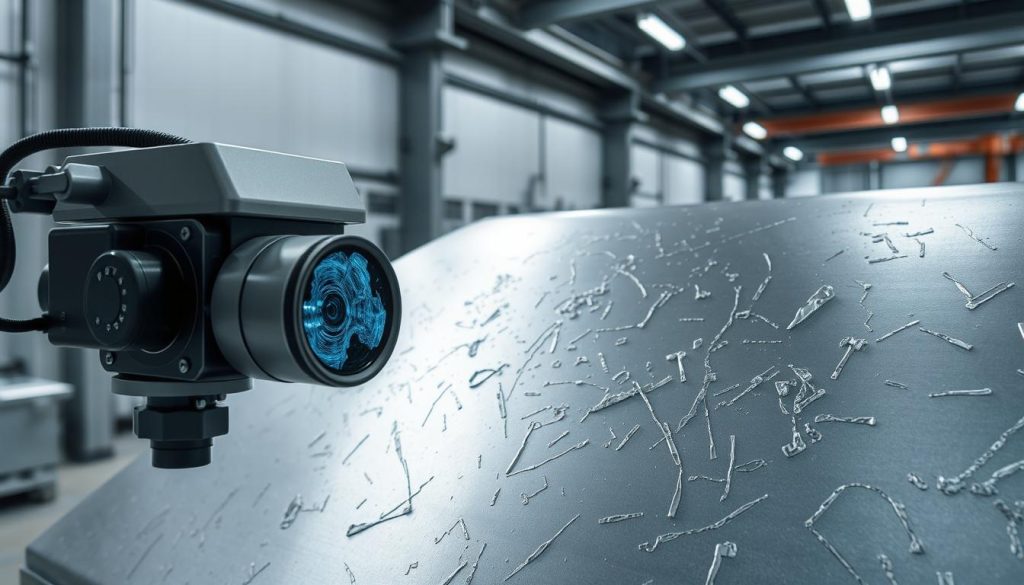Modern production environments require precision that manual checks can’t achieve at industrial scales. We’ve witnessed how visionary approaches to material evaluation help manufacturers maintain rigorous standards while accelerating output. By integrating smart detection tools with cloud capabilities, businesses gain real-time visibility into their operations – a critical advantage in today’s fast-paced markets.
Since pioneering advanced quality systems in 1992, our solutions have evolved to serve diverse sectors from aerospace components to energy storage materials. These systems don’t just identify imperfections – they convert raw data into strategic insights. Production teams use this information to optimize workflows, reduce waste, and make informed decisions that impact their bottom line.
The integration of cloud platforms has revolutionized how companies approach material analysis. Real-time monitoring across global facilities enables rapid response to potential issues, while machine learning patterns help predict maintenance needs. This technological synergy creates a foundation for continuous improvement, allowing manufacturers to stay ahead in competitive industries.
Key Takeaways
- Advanced detection systems outperform manual methods in speed and accuracy
- Cloud integration enables instant data access across production networks
- Smart analytics transform quality metrics into operational improvements
- Cross-industry applications range from precision metals to battery production
- Proactive defect management reduces costs while enhancing output consistency
Introduction to Automated Surface Inspection
In today’s competitive markets, maintaining product excellence demands more than traditional oversight methods. Every component’s integrity directly impacts performance and customer trust. Flaws in critical parts can compromise safety, while cosmetic imperfections damage brand credibility – challenges requiring robust solutions.
Overview of Surface Inspection in Quality Control
We’ve seen how meticulous evaluation forms the backbone of reliable manufacturing. From microscopic cracks in aircraft turbines to uneven coatings on consumer electronics, effective detection systems safeguard both functionality and aesthetics. One aerospace client reduced warranty claims by 37% after implementing advanced evaluation protocols.
Industries handling high-volume production particularly benefit from systematic checks. Our data shows 62% of quality-related returns stem from visible flaws that proper monitoring could prevent. By catching irregularities early, manufacturers avoid costly reworks and preserve hard-earned reputations.
The Role of Automation in Modern Manufacturing
Manual examination struggles with today’s complex geometries and production speeds. We help businesses transition to intelligent systems that deliver millimeter-level precision across 24/7 operations. These solutions adapt to diverse materials – whether analyzing reflective battery foils or textured engine components.
“Consistency separates industry leaders from competitors,” notes a recent manufacturing report. Automated tools provide this reliability through standardized assessments unaffected by human fatigue. Real-time data feeds enable instant adjustments, turning quality assurance into a strategic advantage rather than a compliance cost.
Understanding Automated Surface Inspection Systems
Precision manufacturing demands tools that see beyond human capabilities. Our solutions combine optical innovations with computational power to deliver unmatched accuracy in material evaluation. These technologies form the backbone of reliable production workflows across industries.
Vision-Based Techniques and Sensor Technologies
High-resolution cameras paired with advanced sensors capture details invisible to the naked eye. We use specialized lenses that collect 360-degree surface data, feeding real-time information to processing software. This digital analysis compares live image data against golden standards, flagging deviations as small as 5 microns.

Our vision systems employ multi-spectral sensors to handle reflective materials and complex textures. This approach eliminates guesswork in quality decisions, particularly for components like battery electrodes or medical device coatings.
Laser Scanning and 3D Image Analysis
For intricate geometries, we implement non-contact laser scanners that build detailed surface maps. These tools create micron-accurate 3D models, revealing subsurface flaws traditional methods miss. A recent automotive case study showed 42% faster defect detection using this method.
| Technology | Detection Capability | Speed | Best For |
|---|---|---|---|
| Vision Systems | 0.005 mm defects | 500 units/min | Flat surfaces |
| Laser Scanning | 3D topology | 120 scans/min | Complex shapes |
| Hybrid Solutions | Multi-angle analysis | 300+ checks/sec | High-mix production |
The integration of laser-based inspection with cloud platforms allows instant data sharing across facilities. Production managers gain actionable insights through dashboards showing real-time quality metrics and trend analyses.
Cloud Innovation Empowering Inspection Processes
Cloud advancements are reshaping how manufacturers maintain quality standards. Our solutions leverage distributed computing power to analyze material characteristics at unprecedented speeds. This technological shift enables facilities to process millions of data points while maintaining micron-level accuracy.

Real-Time Data Processing and Remote Monitoring
We transform raw sensor readings into actionable insights within milliseconds. Quality teams receive instant alerts when irregularities emerge, enabling corrective actions before defective products accumulate. One automotive supplier reduced scrap rates by 29% using our live analytics dashboard.
Remote access capabilities let managers oversee multiple production lines from any location. This centralized approach ensures uniform standards across global operations. Decision-makers view trend analyses through secure portals, identifying patterns that drive process improvements.
Integration of Software and High-Resolution Cameras
Advanced algorithms work with 32-megapixel cameras to detect flaws invisible under normal lighting. Our software dynamically adjusts contrast levels, revealing subtle defects like hairline cracks or uneven coatings. This combination delivers human-like discernment with machine consistency.
| Component | Function | Benefit |
|---|---|---|
| Multi-Spectral Sensors | Capture surface reflectance | Detects material inconsistencies |
| Cloud Analytics | Processes image data | Identifies defect patterns |
| Modular Software | Adapts to new products | Reduces retooling costs |
Photometric measurement tools grade imperfections based on severity and location. These quantifiable results help customers prioritize corrective actions while tracking improvement metrics over time. Our systems achieve 99.7% detection accuracy across diverse materials – from polished metals to textured polymers.
Quality Control and Operational Efficiency Gains
Global manufacturers face mounting pressure to deliver flawless products while meeting complex compliance demands. Imperfections as subtle as micro-scratches or smudged labels now carry significant financial consequences – particularly in sectors like consumer electronics where aesthetics influence purchasing decisions.
Reducing Defects and Enhancing Product Quality
We help businesses implement precision detection systems that screen products at production-line speeds. These solutions identify issues ranging from surface defects to incomplete regulatory markings, ensuring every item meets international quality standards. One appliance manufacturer reduced customer returns by 41% after adopting our technology.
Compliance verification forms a critical component of modern quality control. Our tools validate permanent markings required by CE, FCC, and RoHS directives – confirming their resistance to solvents and environmental factors. This prevents costly recalls while maintaining safety certifications across global markets.
Operational improvements emerge through real-time defect tracking. Production teams receive instant alerts when irregularities occur, allowing adjustments before materials waste accumulates. A recent analysis showed clients achieve 23% faster throughput after implementing our feedback-driven processes.
By standardizing evaluation criteria, we eliminate subjective quality decisions that lead to inconsistent results. Our systems adapt to diverse materials – from glass smartphone screens to textured polymer components – delivering uniform precision across all production areas. This approach transforms quality assurance from cost center to strategic advantage.
Conclusion
Modern manufacturing demands precision that traditional approaches can’t sustain. We’ve shown how intelligent quality systems redefine excellence across production lines. These solutions detect flaws invisible to human operators – from hairline fractures in glass bottles to micro-scratches on medical devices.
Our vision technologies now serve diverse sectors, including food packaging and infrastructure maintenance. Contrast-enhanced imaging reveals contaminants in transparent materials, while robotic probes map sewer lines with millimeter accuracy. This evolution in defect detection helps brands maintain safety standards and customer trust.
Cloud integration amplifies these capabilities. Real-time data flows enable instant adjustments across global facilities. Managers access unified dashboards showing quality metrics, turning insights into operational refinements. One beverage producer reduced recall risks by 34% using live monitoring tools.
Investing in advanced evaluation systems delivers measurable returns. Reduced waste, faster throughput, and consistent compliance create competitive advantages. We help manufacturers implement these upgrades strategically – ensuring quality becomes a growth driver, not just a cost center.
FAQ
How do cloud-based solutions reduce costs in quality assurance processes?
Cloud platforms minimize hardware investments while enabling real-time defect detection across production lines. By centralizing data analysis, we help manufacturers identify trends faster, reducing material waste and rework expenses without compromising accuracy.
Can vision-based systems integrate with existing manufacturing equipment?
Yes. Our solutions use adaptive sensor technologies that connect seamlessly with legacy systems through API-driven architectures. This ensures smooth adoption while maintaining compliance with industry-specific quality standards like ISO 9001.
What types of surface flaws can laser scanning detect that human inspectors miss?
3D image analysis identifies micron-level cracks, texture variations, and subsurface anomalies invisible to the naked eye. This precision is critical for aerospace components and medical devices where microscopic defects impact safety.
How does real-time monitoring improve operational efficiency?
Instant feedback loops allow immediate process adjustments, preventing defective batches from progressing. We’ve seen clients reduce downtime by 40% while achieving 99.8% detection rates through live dashboards and predictive analytics.
Are these systems adaptable to non-metallic materials like composites or polymers?
Absolutely. Our multispectral imaging tools analyze diverse surfaces – from reflective metals to matte plastics. Customizable algorithms account for material-specific characteristics, ensuring reliable results across automotive, packaging, and electronics industries.
What cybersecurity measures protect inspection data in cloud environments?
We employ AES-256 encryption, zero-trust architectures, and SOC 2-compliant protocols. Role-based access controls and blockchain-audited logs ensure sensitive production data remains secure while enabling authorized team collaboration.
